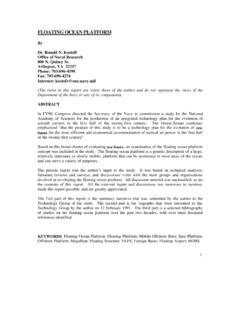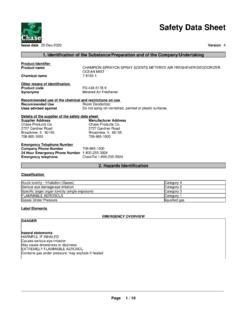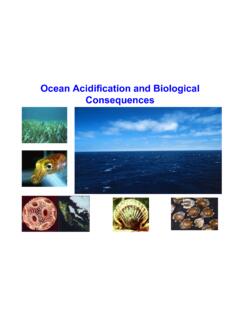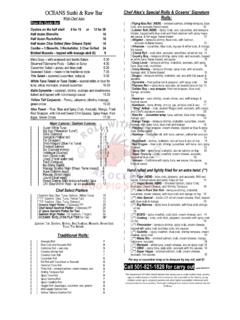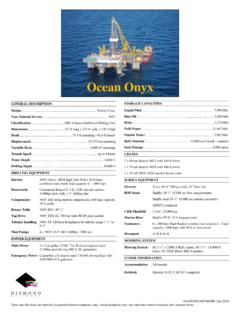Transcription of The Biological Productivity of the Ocean - Mathis Hain
1 Nature Education1 2012 Macmillan Publishers Limited. All rights reservedVol 3 | Issue 6 | 2012 What is Ocean Productivity ? Ocean Productivity largely refers to the production of organic matter by phytoplankton, plants suspend-ed in the Ocean , most of which are single-celled. Phy-toplankton are photoautotrophs, harvesting light to convert inorganic to organic carbon, and they supply this organic carbon to diverse heterotrophs, organ-isms that obtain their energy solely from the respira-tion of organic matter. Open Ocean heterotrophs in-clude bacteria as well as more complex single- and multi-celled zooplankton (floating animals), nek-ton (swimming organisms, including fish and marine mammals), and the benthos (the seafloor community of organisms).
2 The many nested cycles of carbon associated with Ocean Productivity are revealed by the following defi-nitions (Bender et al. 1987) (Figure 1). Gross primary production (GPP) refers to the total rate of organic carbon production by autotrophs, while respiration refers to the energy-yielding oxidation of organic car-bon back to carbon dioxide. Net primary production (NPP) is GPP minus the autotrophs own rate of res-piration; it is thus the rate at which the full metabo-lism of phytoplankton produces biomass. Secondary production (SP) typically refers to the growth rate of heterotrophic biomass. Only a small fraction of the or-ganic matter ingested by heterotrophic organisms is used to grow, the majority being respired back to dis-solved inorganic carbon and nutrients that can be re-used by autotrophs.
3 Therefore, SP in the Ocean is small in comparison to NPP. Fisheries rely on SP; thus they depend on both NPP and the efficiency with which or-ganic matter is transferred up the foodweb ( , the SP/NPP ratio). Net ecosystem production (NEP) is GPP minus the respiration by all organisms in the eco-system. The value of NEP depends on the boundaries defined for the ecosystem. If one considers the sunlit surface Ocean down to the 1% light level (the eupho-tic zone ) over the course of an entire year, then NEP is equivalent to the particulate organic carbon sinking into the dark Ocean interior plus the dissolved organ-ic carbon being circulated out of the euphotic zone. In this case, NEP is also often referred to as export production (or new production (Dugdale & Goering 1967), as discussed below).
4 In contrast, the NEP for the entire Ocean , including its shallow sediments, is roughly equivalent to the slow burial of organic mat-ter in the sediments minus the rate of organic matter entering from the are no accumulations of living biomass in the marine environment that compare with the forests and grasslands on land (Sarmiento & Bender 1994). Nev-ertheless, Ocean biology is responsible for the stor-age of more carbon away from the atmosphere than is the terrestrial biosphere (Broecker 1982). This is achieved by the sinking of organic matter out of the surface Ocean and into the Ocean interior before it is returned to dissolved inorganic carbon and dissolved nutrients by bacterial decomposition.
5 Oceanographers often refer to this process as the Biological pump, as it pumps carbon dioxide (CO2) out of the surface Ocean and atmosphere and into the voluminous deep Ocean (Volk & Hoffert 1985).Only a fraction of the organic matter produced in the surface Ocean has the fate of being exported to the deep Ocean . Of the organic matter produced by phytoplankton (NPP), most is respired back to dis-solved inorganic forms within the surface Ocean and thus recycled for use by phytoplankton (Eppley & Pe-The Biological Productivity of the Ocean Daniel M. Sigman 1 & Mathis P. Hain 1,2 2012 Nature EducationProductivity fuels life in the Ocean , drives its chemical cycles, and lowers atmospheric carbon dioxide.)
6 Nutrient uptake and export interact with circulation to yield distinct Ocean Department of Geosciences, Guyot Hall, Princeton University, Princeton, New Jersey 08544, USA. 2 now at: School of Ocean and Earth Sciences, University of Southampton, Southampton SO143ZH, UKnature Education2 2012 Macmillan Publishers Limited. All rights reservedVol 3 | Issue 6 | 2012terson 1979) (Figure 1). Most phytoplankton cells are too small to sink individually, so sinking occurs only once they aggregate into larger particles or are pack-aged into fecal pellets by zooplankton. The remains of zooplankton are also adequately large to sink. While sinking is a relatively rare fate for any given particle in the surface Ocean , biomass and organic matter do not accumulate in the surface Ocean , so export of organic matter by sinking is the ultimate fate for all of the nu-trients that enter into the surface Ocean in dissolved form with the exceptions that (1) dissolved nutrients can be returned unused to the interior by the circula-tion in some polar regions (see below), and (2) circu-lation also carries dissolved organic matter from the surface Ocean into the interior, a significant process (Hansell et al.
7 2009) that we will not address further. As organic matter settles through the Ocean interior and onto the seafloor, it is nearly entirely decomposed back to dissolved chemicals (Emerson & Hedges 2003, Martin et al. 1987). This high efficiency of decomposi-tion is due to the fact that the organisms carrying out the decomposition rely upon it as their sole source of chemical energy; in most of the open Ocean , the het-erotrophs only leave behind the organic matter that is too chemically resistant for it to be worth the invest-ment to decompose. On the whole, only a tiny frac-tion (typically much less than 1%) of the organic carbon from NPP in the euphotic zone survives to be buried in deep sea in coastal ecosystems is often dis-tinct from that of the open Ocean .
8 Along the coasts, the seafloor is shallow, and sunlight can sometimes penetrate all the way through the water column to the bottom, thus enabling bottom-dwelling ( benthic ) organisms to photosynthesize. Furthermore, sinking organic matter isintercepted by the seabed, where it supports thriving benthic faunal communities, in the process being recycled back to dissolved nutrients that are then immediately available for primary produc-tion. The proximity to land and its nutrient sources, the interception of sinking organic matter by the shal-low seafloor, and the propensity for coastal upwell-ing all result in highly productive ecosystems. Here, we mainly address the Productivity of the vast open Ocean ; nevertheless, many of the same concepts, albeit in modified form, apply to coastal Does Ocean Productivity Need?
9 Phytoplankton require a suite of chemicals, and those with the potential to be scarce in surface wa-ters are typically identified as nutrients. Calcium is an example of an element that is rapidly assimilated by some plankton (for production of calcium carbonate hard parts ) but is not typically considered a nutrient because of its uniformly high concentration in seawa-ter. Dissolved inorganic carbon, which is the feedstock for organic carbon production by photosynthesis, is also abundant and so is not typically listed among the nutrients. However, its acidic form dissolved CO2 is often at adequately low concentrations to affect the growth of at least some OCEANNEP heterotrophicrespirationnet nutrient supplyby upwelling & mixingexport of particualte &dissolved organic matterPhytoplanktonZooplankton& Bacteria+ = NPPnutrientrecycling+ + = GPPnutrientuptakegrazing= NEP =autotrophicrespirationFigure 1.
10 Productivity in the surface Ocean , the definitions used to describe it, and its connections to nutrient cycling. The blue cycle for net ecosystem production (NEP) ( new or export production) encompasses the new nutri-ent supply from the Ocean interior, its uptake by autotrophic phytoplankton growth, packaging into large particles by heterotrophic grazing organisms, and sinking of organic matter out of the surface Ocean . The red cycle illustrates the fate of the majority of organic matter produced in the surface Ocean , which is to be respired by heterotrophic organisms to meet their energy requirements, thereby releasing the nutrients back into the surface water where they can be taken up by phytoplankton once again to fuel regenerated production.


